Addition to alkene - Study guides, Class notes & Summaries
Looking for the best study guides, study notes and summaries about Addition to alkene? On this page you'll find 225 study documents about Addition to alkene.
Page 3 out of 225 results
Sort by
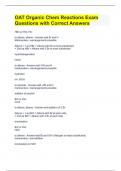
-
OAT Organic Chem Reactions Exam Questions with Correct Answers
- Exam (elaborations) • 13 pages • 2024
-
Available in package deal
-
- $14.49
- + learn more
HBr (or HCl, HI) to alkyne, alkene - Answer-add Br and H Markovnikov, rearrangements possible Alkyne + 1 eq HBr = Alkene with Br at most substituted + 2nd eq HBr = Alkane with 2 Br at most substituted hydrohalogenation H3O+ to alkene - Answer-add -OH and H markovnikov, rearrangements possible hydration H+, ROH to epoxide - Answer-add -OR and H markovnikov, rearrangements possible addition of alcohol Br2 or Cl2/ CCl4 to alkyne, alkene - Answer-anti-addition o...
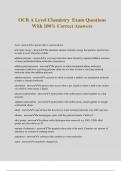
-
OCR A Level Chemistry Exam Questions With 100% Correct Answers
- Exam (elaborations) • 11 pages • 2024
-
- $12.49
- + learn more
OCR A Level Chemistry Exam Questions With 100% Correct Answers Acid - answerA species that is a proton donor. activation energy - answerThe minimum amount of kinetic energy that particles need to have in order to react when they collide addition polymer - answerA very long molecular chain formed by repeated addition reactions of many unsaturated alkene molecules (monomers). addition polymerisation - answerThe process in which unsaturated alkene molecules (monomers) add on to a growing po...
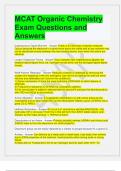
-
MCAT Organic Chemistry Exam Questions and Answers
- Exam (elaborations) • 20 pages • 2024
-
- $12.49
- + learn more
MCAT Organic Chemistry Exam Questions and Answers Instantaneous Dipole Moment - Answer-Exists in an otherwise nonpolar molecule. Occurs because the electrons in a bond move about the orbital and at any moment may not be distributed exactly between the two bonding atoms, even when the atoms are identical. London Dispersion Forces - Answer-Occur between two instantaneous dipoles; the weakest dipole-dipole force (vs. hydrogen bonds which are the strongest dipole-dipole forces). Wolff-Kishner...
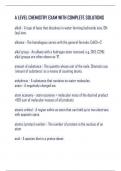
-
A LEVEL CHEMISTRY EXAM WITH COMPLETE SOLUTIONS alkali - A type of base that dissolves in water forming hydroxide ions, OH- (aq) ions. alkanes - The homologous series with the general formula: CnH2n+2. alkyl group - An alkane with a hydrogen atom
- Exam (elaborations) • 42 pages • 2024
-
- $19.99
- + learn more
A LEVEL CHEMISTRY EXAM WITH COMPLETE SOLUTIONS alkali - A type of base that dissolves in water forming hydroxide ions, OH- (aq) ions. alkanes - The homologous series with the general formula: CnH2n+2. alkyl group - An alkane with a hydrogen atom removed, e.g. CH3, C2H5; alkyl groups are often shown as 'R'. amount of substance - The quantity whose unit of the mole. Chemists use 'amount of substance' as a means of counting atoms. anhydrous - A substance tha...
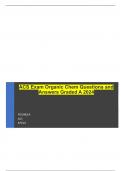
-
ACS Exam Organic Chem Questions and Answers Graded A 2024
- Exam (elaborations) • 6 pages • 2024
-
Available in package deal
-
- $14.49
- + learn more
O-H and N-H IR shift - 3400 cm⁻¹ C-H SP³ IR shift - cm⁻¹ C-H SP₂ IR shift - cm⁻¹ C-H SP IR Shift - 3300 cm⁻¹ 3x bond C-C IR shift - 2100 cm⁻¹ C=O IR shift - 1700 cm⁻¹ C=C and C-C aromatic IR shift - 1600 cm⁻¹ Aromatic C-C IR shift - 1500 cm⁻¹ HNMR shift of methyl hydrogen - 1 ppm HNMR shift of hydrogen attached to SP2 carbon - 2 ppm HNMR shift of aromatic hydrogen - 7-8 ppm HNMR shift of hydrogen attached to SP3 carbon attached to a p...
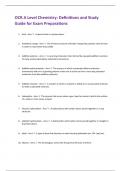
-
OCR A Level Chemistry: Definitions and Study Guide for Exam Preparations
- Exam (elaborations) • 16 pages • 2024
- Available in package deal
-
- $10.49
- + learn more
1. Acid - Ans .A species that is a proton donor. 2. Activation energy - Ans .The minimum amount of kinetic energy that particles need to have in order to react when they collide 3. Addition polymer - Ans .A very long molecular chain formed by repeated addition reactions of many unsaturated alkene molecules (monomers). 4. Addition polymerisation - Ans .The process in which unsaturated alkene molecules (monomers) add on to a growing polymer chain one at a time to form a very long saturate...
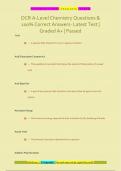
-
OCR A-Level Chemistry Questions & 100% Correct Answers- Latest Test | Graded A+ | Passed
- Exam (elaborations) • 43 pages • 2024
- Available in package deal
-
- $13.49
- + learn more
Acid ֎ -:- A species that releases H+ ions in aqueous solution Acid Dissociation Constant Ka ֎ -:- The equilibrium constant that shows the extent of dissociation of a weak acid Acid-Base Pair ֎ -:- A pair of two species that transform into each other by gain or loss of a proton Activation Energy ֎ -:- The minimum energy required to start a reaction by the breaking of bonds Actual Yield ֎ -:- The amount of product obtained from a reaction Addition Polymerisation E x c e l l e ...
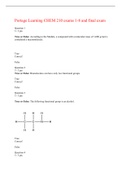
-
PORTAGE LEARNING CHEM 210 exams 1-8 and final exam
- Exam (elaborations) • 124 pages • 2023
-
- $28.99
- 5x sold
- + learn more
Portage Learning CHEM 210 exams 1-8 and final exam Question 1 3 / 3 pts True or False: According to the Module, a compound with a molecular mass of 1,000 g/mol is considered a macromolecule. True Correct! False Question 2 3 / 3 pts True or False: Biomolecules can have only two functional groups. True Correct! False Question 3 3 / 3 pts True or False: The following functional group is an alcohol. True Correct! False Question 4 3 / 3 pts True or False: In ...
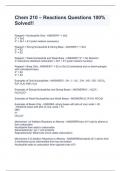
-
Chem 210 – Reactions Questions 100% Solved!!
- Exam (elaborations) • 6 pages • 2024
-
Available in package deal
-
- $11.99
- + learn more
Reagent = Nucleophile Only - ANSWER1° = Sn2 2° = Sn2 3° = Sn1 + E1 (polar medium necessary) Reagent = Strong Nucleophile & Strong Base - ANSWER1° = Sn2 2° = E2 3° = E2 Reagent = Weak Nucleophile and Weak Base - ANSWER1°/2° = No Reaction 3°/resonance stabilized carbocation = Sn1 + E1 (polar medium necessry Reagent = Base Only - ANSWER1° = E2 or Sn2 (if unhindered and no beta-hydrogen with unhindered base) 2° = E2 3° = E2 Examples of Only Nucleophiles - ANSWERCl⁻, ...
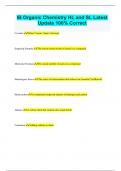
-
IB Organic Chemistry HL and SL Latest Update 100% Correct
- Exam (elaborations) • 7 pages • 2024
-
Available in package deal
-
- $8.99
- + learn more
IB Organic Chemistry HL and SL Latest Update 100% Correct Covalent When 2 atoms "share" electrons Empirical Formula The lowest whole # ratio of atoms in a compound Molecular Formula The actual number of atoms in a compound Homologous Series The series of hydrocarbons that follows the formula C(n)H(an+b) Hydrocarbon A compound composed entirely of hydrogen and carbon Alkanes A carbon chain that contain only single bonds Catenation Adding carbons to chain Isomer/Struct...

$6.50 for your textbook summary multiplied by 100 fellow students... Do the math: that's a lot of money! Don't be a thief of your own wallet and start uploading yours now. Discover all about earning on Stuvia


